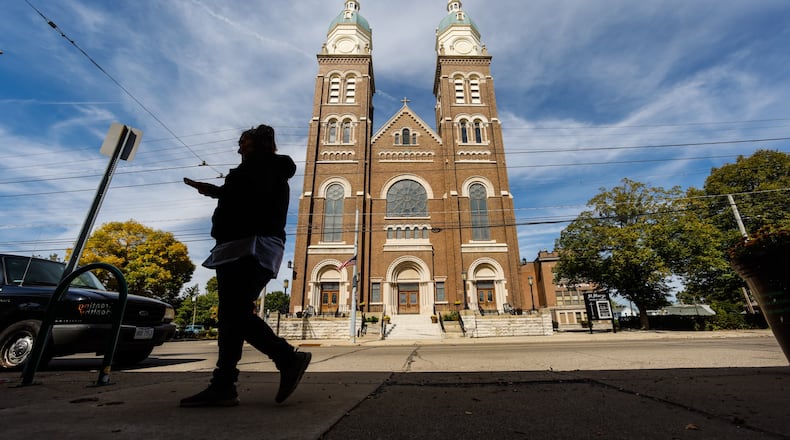Today’s churches and Mass schedules were built for a “different era,” the archdiocese of more than 440,000 Catholics also said. “In many cases, our church buildings are grossly underutilized.”
The average Sunday Mass is about one-third full, the archdiocese said.
More than a year in the making, the draft does not point to the immediate closing of any parishes or schools.
Instead, parishes are grouped in what the Archdiocese calls “families.” Decisions about scheduling of Masses and use of resources will be made within those groups, with the expectation that, over time, some parish buildings could be used less, closed or reduced to the status of a “chapel” or an “oratory” — no longer regularly open for Sunday Masses, archdiocesan leaders said.
A “family” of parishes may decide it does not need all its church campuses, Archbishop of Cincinnati Dennis Schnurr said in an interview video on the Archdiocesan website. “We can accomplish this with fewer campuses — and then there may be the decision to reduce a parish church to the status of an oratory or a chapel.”
He added: “But that is going to decided by the family of parishes. It’s not going to be decided by me … or the Archdiocese of Cincinnati.”
‘Staying where we are is not a possibility’
The order of parishes listed in the draft plan has no special significance, an archdiocesan spokeswoman said.
“There is no type of ordering of parishes in the family lists,” spokeswoman Jennifer Schack said. “And there is no lead parish as part of the design of the families.”
The plan also does not immediately address the future of parochial schools tied to parishes, but leaves those choices to local parishes.
“It is accurate that the future of Catholic schools will be decisions made by the families of parishes at the local level after implementation of the families (plan) in July of 2022,” Schack said in an email to this newspaper Thursday.
The reorganization was crafted by a consultant, then reviewed by Schnurr, priests leading 12 deaneries across Southwestern Ohio and others, the archbishop said.
Consultant Partners Edge LLC, based in the Minneapolis area, drafted a “current realities” demographics report for the Archdiocese.
The company said it provides dioceses “systemic and detailed assessment of your current conditions, strengths and challenges” and creates “scenario models of your future vision conditions.”
Area priests were supposed to get a look at the draft Wednesday.
In an interview before the release of the draft, Schack said, “We’ve gotten to a place where the projection is: Staying where we are is not a possibility. So there will need to be a restructuring, there will need to be a new arrangement for our hopeful future.”
The next steps include a comment period on the draft until Oct. 20. The final reorganization announcement is expected by late November. Implementation is set for July 1, 2022.
A website to offer comments is expected to be open today at BeaconsAOC.org, officials said. Comments may also be sent to: Beacons of Light c/o Archdiocese of Cincinnati, 100 E. Eighth St., Cincinnati, OH 45202.
‘If I were alone, it would be a different ballgame’
Rev. Satish Joseph already leads the parishes of St. Mary and Immaculate Conception in Dayton and St. Helen in Riverside. If the draft becomes final without alteration, his group of parishes would widen — at least at first — to include St. Anthony and Holy Angels parishes, both in Dayton.
Joseph said in an interview that his first reaction to the draft is that it’s a draft.
“There are bound to be changes,” he said.
The goal of the effort is to position parishes for growth, not simply “maintenance,” he said.
His expectation is that he and other pastors will have help, that there will be parochial vicars and associate pastors who will help him and other pastors in a job that might be seen as daunting. “When the workload is higher, I’m sure there will be more than one person helping,” he said.
He added: “It’s impossible for one person to do this by themselves. It’s also dependent on the fact that I will have help. If I were alone, it would be a different ballgame.”
“Am I taking this as an easy task?” Joseph said. “No. But with the help of other folks, nothing is impossible.”
‘Our priests are stretched to the limit’
While the Catholic population in Southwestern Ohio has fallen about 16% since 1970, it’s the drop in the number of priests that has presented a substantial challenge.
In 1970, the archdiocese counted 417 active diocesan priests, approaching 450 available priests total, serving about 259 parishes at the time.
While there are different ways of counting priests, an archdiocesan report points to about 160 active priests today (in his video, Schnurr put the number at 150) serving about 208 parishes — a reduction in the number of priests of some 61%, compared to 51 years ago.
“These priests have been asked to do more and more,” Schnurr said in the nearly 20-minute video. “It is already impacting the health and well-being of our priests, emotionally, psychologically, spiritually, physically.”
“In particular, our priests are stretched to the limit, and we will have fewer priests who can serve as pastors over the coming years,” the archdiocese said in a statement accompanying the release of the draft plant.
The number of archdiocesan priests available for assignment is projected to decline by another 20% over the next five years.
In addition, religious practice has been declining in both the United States and in the archdiocese. From 2010 to 2019, sacramental practice — baptisms, first communions, confirmations and weddings — in the archdiocese declined by 23%.
About the Author



